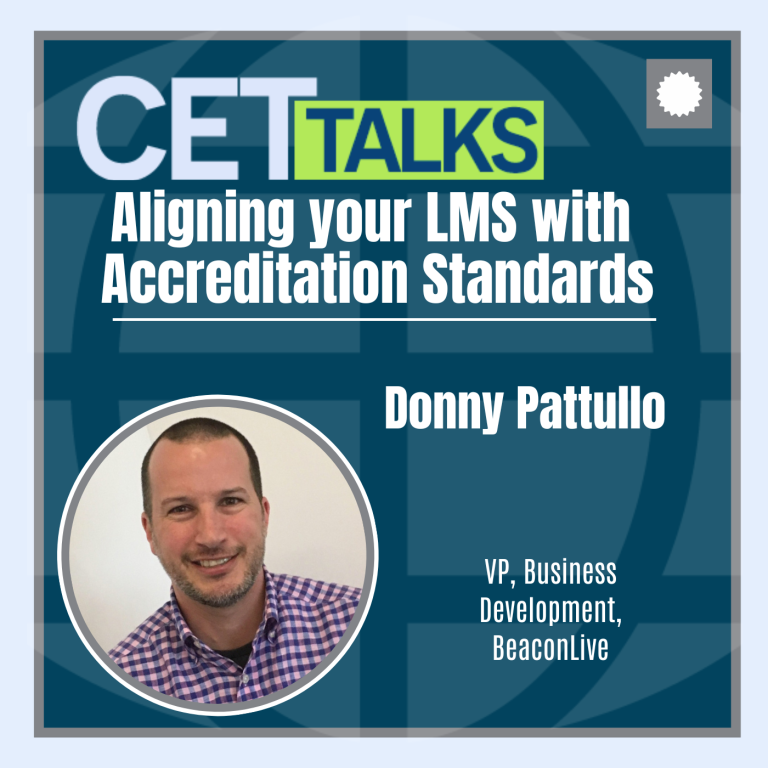Episode 03
.
CET Talks: Accreditation, Learning and Leadership
Episode 03
JULY 6 2023 . 34 MINUTES
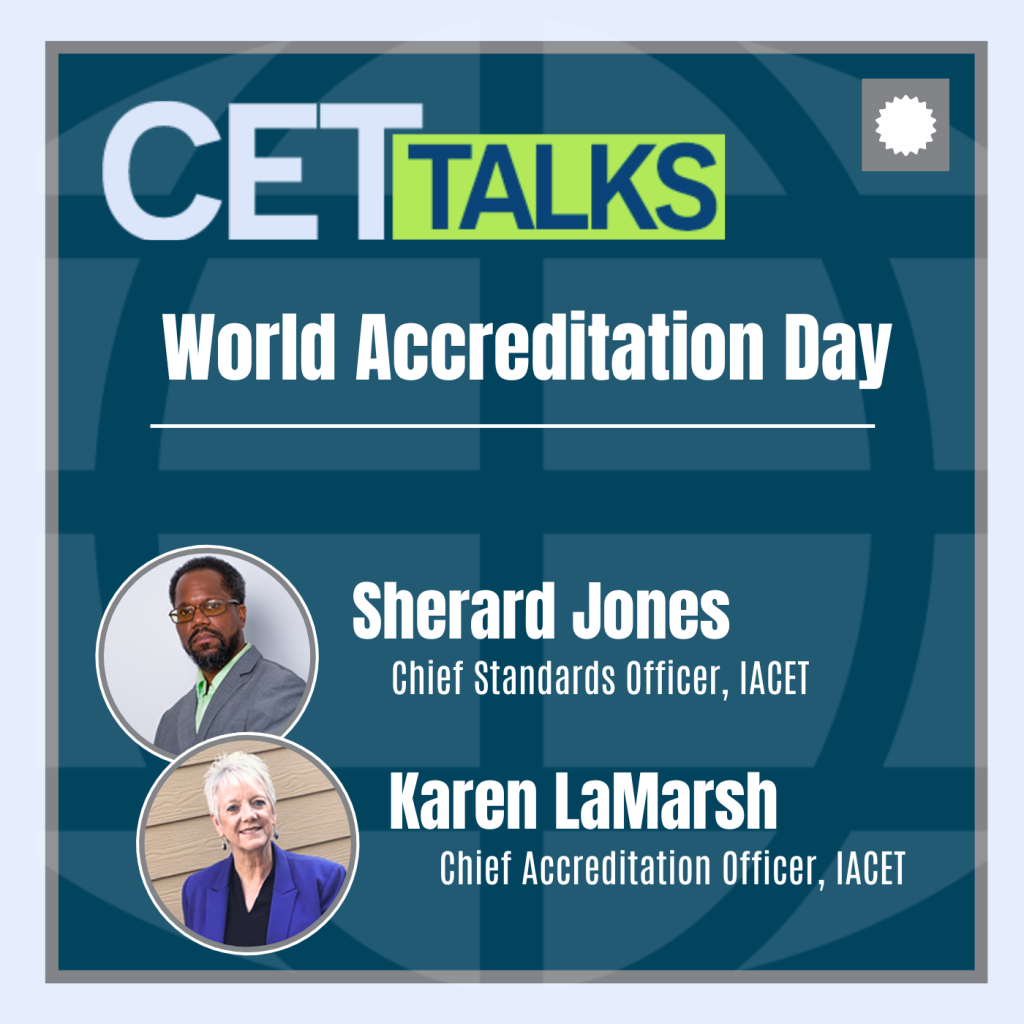
World Accreditation Day
To celebrate World Accreditation Day, Randy Bowman, Interim President and CEO of IACET, and co-host and certified corporate wellness specialist Mike Veny, were joined by CAO (Chief Accreditation Officer) and CSO (Chief Standards Officer) Sherard Jones, and Karen LaMarsh, as they discuss what standards are and why they matter. Discover the process of getting your organization accredited by IACET, and where organizations often struggle the most in the process of pursuing accreditation. You’ll also hear about the value of IACET’s CET accreditation for organizations.
Listen to the Podcast
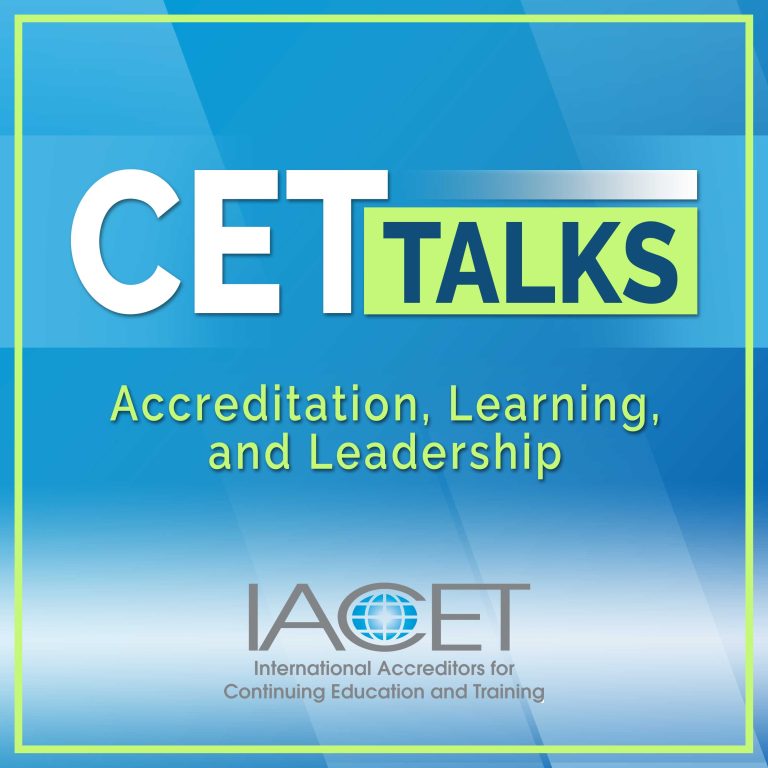
Welcome to CET Talks, the International Accreditors for Continuing Education and Training’s podcast, where we convene thought leaders in the continuing education and training ecosystem to share ideas, research, best practices, and experiences that promote the creation of a world that learns better. Your hosts are Randy Bowman, Interim President and CEO of IACET, and certified corporate wellness specialist Mike Veny.
To celebrate World Accreditation Day, Randy Bowman, Interim President and CEO of IACET, and co-host and certified corporate wellness specialist Mike Veny, were joined by CAO (Chief Accreditation Officer) and CSO (Chief Standards Officer) Sherard Jones, and Karen LaMarsh, as they discuss what standards are and why they matter. Discover the process of getting your organization accredited by IACET, and where organizations often struggle the most in the process of pursuing accreditation. You’ll also hear about the value of IACET’s CET accreditation for organizations.

Transcription
Host: Welcome to CET Talks, the International Accreditors for Continuing Education and Training’s podcast, where we convene thought leaders in the continuing education and training ecosystem to share ideas, research best practices, and experiences that promote the creation of a world that learns better. Enjoy the episode.
Randy Bowman: Hi, welcome to CET Talks. My name is Randy Bowman, and I’m your IACET Staff host.
Mike Veny: And I am the CET co-host, Mike Veny. I’m a certified corporate wellness specialist, and my company is an IACET-accredited provider. Randy, hello.
Randy Bowman: Hello. It’s been so long.
Mike Veny: It’s been so long. I just wanted to say something to you. No one can really see this, but I’ve got these notes that you’ve helped us organize, and they’re so nice and they’re branded, like really well branded with the IACET branding.
Randy Bowman: Mike, you’ve got to have standards. The details matter.
Mike Veny: I guess they do, and that is a perfect introduction for today’s lovely guests. I’ve had the opportunity to not only meet with in person, but work with and dine with in person, Dr. Karen LaMarsh, IACET’s Chief Accreditation Officer, and Sherard Jones, IACET’s Chief Standards Officer. Karen and Sherard, welcome to the show.
Dr. Karen Marsh and Sherard Jones: Hey, thanks for having us. Thank you.
Mike Veny: Before we begin, I like to remember that some people don’t know what standards are. Sherard, I want to start with you. What are standards and why do they matter?
Sherard Jones: All right. First, before we get into that, you guys have amazing podcast voices. I will do my best to match your level of energy and awesomeness. I think, short and sweet, what a standard is, is an established model or a point of reference for quality. If we expand that out a little bit further, what it provides is a blueprint. What a best practice looks like when it’s codified in order to reliably deliver the same results. Where that’s useful, particularly in the marketplace, is it gives specifications, it gives a direction for people who are developing processes, products, services. What happens is they now have a minimum standard, and not to use the word again, but let’s say a minimum bar that they have to reach in order to call something a quality service or a quality product or a quality process. Ultimately, what that does is it protects the marketplace. What it then allows you to do is to be able to determine who’s performing well versus who isn’t performing well in the marketplace. When you’re trying to choose a product that you want to use, when you’re trying to choose a process that you want to employ, when you want to choose a service that someone is offering or providing to you. What you have to keep in mind is that standards are closely aligned to the process of accreditation, which is also known as conformity assessment. One of the core elements of a standard is it creates a body that you can conform to. In conforming to that standard, you can demonstrate your quality, you can demonstrate your viability through a third party review of your assessment to that standard. That’s pretty much what accreditation is, where in another organization, or it could be the same organization that developed the standard, say, “Hey, let’s come up with a reliable process where we can compare you to this standard.” So they present that, or they go through that process uniformly the same way that the standard is developed uniformly. If there’s one word when it comes to standards that I think is the best, is structure. Then the second word after structure is clarity. When you put these two principles together, it gives people a framework or it gives them the tools so they can build a framework, so they can reliably deliver quality. Did that answer the question?
Randy Bowman: I think so. Great. I love that you started to talk a little bit about how standards and accreditation relate. So, Karen, you oversee the IACET accreditation program, but where do you see organizations struggling the most in the process of pursuing IACET accreditation or any accreditation? Where do you think organizations struggle the most?
Dr. Karen LaMarsh: I would have to say documentation. That’s probably where most people struggle. Many of the organizations that we work with, they have their policies, the application is made up of their accreditation process, and the application are made up of policies, processes, and evidence. They have their policies and they’re even using processes, but they don’t always have the documentation of the processes. They even have the evidence that they’re using processes, but they don’t always have it documented very well. Maybe they don’t even have it documented at all. They’re doing them, but they may not have written them down so that they’re captured and can be reproduced on a consistent basis. IACET is always looking for a detailed process that describes the step-by-step procedures to accomplish a task or produce an output by a certain role done at a predetermined timed or a specific frequency using a particular tool. That’s what we’re talking about when we talk about a process. A close second would be that I find applicants, they tend to want to complicate the process. All we want to know is what do you do right now? How do you address this particular element? Don’t try to over complicate it. Just tell us what you’re doing right now. What is your policy for this, and what is your process for this? Just tell us what you’re doing. Don’t try to make it elaborate. Don’t try to make it more than it is. If you only have one or two or five or 10 people, just tell us what you’re doing right now, not what you hope to do in the future. Just tell us what you’re doing right now. That’s what we’re looking for. And realize too, we’ve put resources out there on the website. Please take advantage of them, use those resources. Believe it or not, we’re really pulling for you. We want you to be successful with the process.
Randy Bowman: Yeah, that’s so true. So true. All right. You’re talking about policies and processes and evidence. For those of you out there who are interested in getting your organization accredited by IACET, we have the ANSI IACET 2018 Standard for Continuing Education and Training. One of the criteria says something to the effect of, the provider shall have a policy for ensuring the privacy and information security of learners records that addresses the role of information, input, maintenance release, and issuance of learners records following learning event completion. That’s a mouthful. Now suppose I’m trying to become accredited, and I read that, and I go, “Well, what does that look like if I want to meet that standard?” Sherard, you were a commissioner at one time, so you’ve reviewed probably hundreds of applications. To meet that standard, if I just show you my privacy policy on my website, is that all you’re looking for?
Sherard Jones: It’s not. I think more so than just that, you say you do something, to Karen’s point, we want evidence that you actually do it. So, a policy statement is one thing, and in my tenure as a commissioner, that is something that I saw, to Karen’s point, is people would create these elaborate statements and say that they were doing these things, maybe under the impression that they could impress us. The goal is not for you to impress us. The goal is for you to demonstrate to us that you do what the standard is asking for you to do. In the case of this policy, it’s one thing for you to have a policy that you’ve written up and you’ve made available for learners to review. That’s one thing. The most important part of it is what do you do to enforce this policy? What do you do to ensure that your staff is consistently applying this policy? What are you doing to ensure that documentation related to the issues come out of violations of this policy? What happens with those? What happens when you need to change the policy? What we’re looking for is that systematically your organization is thinking about the things that are going to impact the stakeholders. Fundamentally, that’s what the standard is about. The standard is about ensuring the stakeholders are getting what they need from learning programs. We’ve developed a standard to address the quality in learning programs that would successfully serve these stakeholders. In this case, a policy is not just going to be a statement you make, but it’s going to be something you’re able to support that ultimately is going to benefit the stakeholders or the learners or the employers or anybody who’s affected by the fact that the standard exists. So long story short, in this case, if we’re talking about a policy for learner records, we want to be sure what you tell the public you do is what you do, and you have the systems in place to reliably do it. So I think that’s it.
Mike Veny: This is a very triggering conversation for me because it was just a few years ago, our company was pursuing accreditation. I’m actually going back in time to this whole section here. It was like learner records, and one of the questions I had was, what does evidence look like? Sherard, you answered that in many ways. I’m curious to hear from you, Karen, can you just be a little more specific for those listening who might be in the process of accreditation? What does evidence look like?
Dr. Karen LaMarsh: Evidence, I think Sherard touched on it, and sometimes it’ll be just a screenshot of your policy. It could be a screenshot of your policy on your website. A lot of organizations take their policy for privacy records, and they use it as a footer on their website, on each of their pages, on their website. They say, here’s where it is, here’s how we communicate it and they’ll give us a screenshot of that. In other places in the application where you tell us that you have a process and we say, okay, this is the process, this is how you’re doing it. And then we say, provide us some evidence that you’ve actually conducted this process. We want to see actual evidence that you’ve done it. For instance, you say, “We have an email template that we use to inform our learners that they have successfully completed a course or that they did not complete a course.” In the process, you give us that template that informs them that they did or did not complete the course. In the next part, part B, we ask for you to provide evidence that you’ve actually done this. Not just tell us about it but show us that you’ve actually done this. In that next part, we want to see the evidence, we want to see an actual email that you sent to a learner. Now, we do know that we want to protect the privacy of people, so you can redact the information, any kind of identifying information that you might have, you can redact that information out of it. But we want to see that actual email that went out to a particular learner. That would be evidence, but a completed checklist, completed learner evaluations with information redacted from it, but enough that we can see somebody actually did do this. Don’t just tell us that this is what you do but show us that this is something that was actually done and completed. Those are the kind of things that we’re looking for.
Randy Bowman: Nice. So IACET has this continuing education and training standard. What does it actually measure? Sherard, what does our standard look like?
Sherard Jones: Okay, so our standard has nine elements to it currently, or rather nine categories. And I hate to bore you, but I just want to run through the nine categories and in a little bit how they relate. The first is organization responsibility and control. The second is learning environment and support systems. The third is planning and instructional personnel. The fourth is needs analysis. The fifth is learning outcomes. The sixth is content and instructional requirements. The seventh is assessment of learning outcomes. The eighth is awarding the CEU and maintaining learner records. And the ninth is evaluation of learning events. Whew, that’s a lot. It’s a lot. That’s why people have to embark upon a journey to complete our process. The goal is for you to be better after you go through all of this. But how do these relate is if we think of them as buckets. One bucket is related to how your organization is structured and how your organization functions in a way that’s going to allow you to consistently deliver, develop, and evaluate quality learning programs. That’s the first section. When we’re talking about section one, section two and three, how are you organized? How do you employ this organization to ensure that learners are supported? How do you ensure that your staff is prepared to do the job, to ensure that learners are supported, and they receive quality learning? That’s bucket number one. The next bucket is going to be those elements that are related to instructional design. That’s element four, element five, element six, and element seven. So that’s when we’re looking at, what did you look at to determine that you needed to develop this course? How did you put it together? What were the learning outcomes? How did you decide you were going to deliver it? And how did you assess learning occurred? So that’s all the instructional design methodology. And also, when everything is said and done, how do we evaluate what happened? How do we evaluate that this is a good course, and it did what we set out for it to do? So, that’s the next kind of bucket. The final bucket is the awarding of the CEU and the maintaining of the learner records. That’s going to be specifically informational. How do you ensure that there’s continuity between learners? How can you ensure there’s continuity from one person who took your CEU course in 2017 to the person who took your CEU course in 2022? Do you have those records? How can I verify someone took your course? And how are they able to maintain a record of their participation? These are the things the standard is concerned about, once again, with ensuring you can reliably deliver a quality program. They all work together to reveal to us the processes, the policies, and the documentation that demonstrates that.
Mike Veny: Thank you, Sherard. For those listening, Karen, what would you tell them is the value of IACET’s CET accreditation to their organization? Why even get involved?
Dr. Karen LaMarsh: Because it’s so much fun? No, Mike, I think the best people to answer this question are accredited providers, and I’ve pulled a little bit of information from some of our surveys. I think they say it best. “It demonstrates to our learners that we have standards and processes in place utilized in the development of our learning content.” “Following IACET guidelines has improved all aspects of our training.” These are people who have just completed the accreditation process. “Just the process of attempting to meet the standard has vastly improved our organization, and the application process itself drives us to be a better organization.” “Our organization is demonstrably better for having undergone the accreditation process.” “To offer CEUs and have third party input on our training program was important to us.” “We believe that IACET is the gold standard for all training and development organizations.” And I thought this was a neat value. “We like the opportunity to provide our employees certified staff with CEUs so they can maintain their licenses. This is good for internal professional development of employees and as a recruiting tool.” And then lastly, “IACET is an ANSI-based standard and is much more rigorous than other organizations.”
Randy Bowman: Wow. That’s a lot of value.
Dr. Karen LaMarsh: Yeah.
Randy Bowman: And I love that you used accredited providers. Reminds me of our last podcast when I was talking to Mike and Mike was answering that question himself. So Sherard, Mike was like, are we going to be able to get him to talk about standards? I’m like, don’t worry. He loves to talk about standards. He tells this story about this time he was standing in line to get jerk chicken. Sherard, tell us, how do jerk chicken and standards go together?
Sherard Jones: Alright, so before I do that, I have to set this up like one of my favorite filmmakers, Guy Richie, and I’ve got to tell you the backstory first. So before we get into jerk chicken and standards, I want to talk about how huge the world of standards is because a lot of times we don’t realize just how much standards impact our daily day-to-day life. Once I got into this world, it was like the curtain got pulled back and I said, “Wait a minute, there’s a standard for my garbage can” and “Hold on, there’s a standard for the resistors in my toaster oven.” There are standards for everything, and there are so many people who work to develop these standards, to improve these standards, and to propagate these standards. So, one of the words that I didn’t touch on was consensus-based. When we talk about our standard and the world that we operate in, our standards, what’s called consensus-based, which means that we brought a bunch of people together, and they all gave input, and agreed that this was going to be the best way to present this standard. That’s the same way that we develop standards. We bring people from across all of our stakeholder groups. We sit at a table, and we say, “What’s important for the people in this industry for continuing education and training to know, to do, and to demonstrate for quality learning programs?” So, all that to say, standards are everywhere, and you need standards in order to function. At the jerk chicken place. So, I go into the jerk chicken place and most places that you go to jerk chicken, it could be a taco place. Any place where they serve food, they will proudly hang on the wall, their food handler certificate, because you need a food handler certificate for the people in this space to legally be able to handle food. Everyone has to get this certification. My son, he’s a college student; he’s home, and he works for the local Dunkin Donuts. He had to get this certification; everybody has to have it. In the state of Illinois, if you want to deliver food handler training, you have to be accredited under ANSI program scheme, right? What happened was the accreditation process is always the same. It starts with some standard; a group of people get together and say this is how this is done. And then once they agreed, this is how this is done, another group of people say, “Hey, how do we measure that someone is doing this well according to this standard?” And once they said, “How do we figure out how to see if someone is doing this well according to this standard?”, they come up with a scheme to accredit according to that standard where they, in our case, gather evidence and you review documentation and you talk to people. And across the board, most accreditation processes look the same, with these core elements, where there’s a review of documentation. There are conversations with staff, and there’s pretty much the triangulation and the verification of what’s been presented. So, in the jerk chicken place, there is this food handler certificate that says that this was an ANSI-accredited program that produced the certificate that this restaurant uses to demonstrate that they comply with food handler requirements in the state of Illinois. Which means that they went through that entire process where there was a standard developed, and then there was an accreditation group that said, we’ll accredit to it. Then there were individuals who assessed their conformity through looking at documentation and having interviews. And they said, “Yeah, this is a good program.” Now the marketplace can, with confidence, purchase this food handler program knowing that it meets the rigor for a quality food handler program, and they can proudly hang it on their wall. That’s what happened when I went to the jerk chicken place, and that’s what happened when I went to the taco place. That’s what happened when I went to the hoagie place, is I saw the food handler certificate. I always beam with Pride because I’m a member of that ecosystem. I know what this means, I know the value of it, and we’re saving lives every day.
Mike Veny: Wow. Thank you for sharing that. But you didn’t share the most important standard. How was the jerk chicken? Was it good jerk chicken?
Sherard Jones: It was fantastic jerk chicken, actually. Okay. So, typically when I go to jerk chicken places, I just want a bunch of wings. The wing is my favorite part of the chicken. Gimme like six wings and some mac and cheese and some plantains, and I’m good. They met my standard for jerk chicken wings.
Mike Veny: And my standard for jerk chicken is if they have attitude in the place and it looks like a health code violation is probably really good food. That’s my standard, just saying. But being that we are all about trying to make a world that learns better, I want to ask this question to the both of you, and I’m really excited to ask it to the both of you. I’m really excited to hear your answers. What does a world that learns better look like to you? I’m going to start with you, Karen.
Dr. Karen LaMarsh: Okay. So I, what I think about is learning that takes place at multiple levels. And in this world where we are, it starts with the applicant and the AP because they come back for reaccreditation, too. What I find is the applicant organization starts with getting the standard for continuing education and training. As I stated earlier, many of them talk to us about going through the process and how it improves their organization and what they learn through the process. I’ve got a quote from one of one of our applicants who said that it made them stronger in learning how to conduct their learning events and how to run their unit professionally and in a manner that if scrutinized, holds up because of the rigorous process and guidance they receive from IACET and reviewers. I thought that was great. So, as training providers, they provide excellent learning experiences for their learners. Through this process they learn, but what are they doing? They’re providing learning for their learners: they’re benefiting from it. So, that’s at multiple levels. They’re able to learn better. They’re learners and because we’re always touting continuous improvement, and that’s built into the process, they’re doing comprehensive evaluation processes. They’re getting feedback about their learning events. They’re going to learn again about their own programs and that’s going to feed into them continuously improving. And then here we are at IACET, and we’re constantly asking for feedback. How was the accreditation process? How was the workshop? How was the webinar? How was everything that you’re doing with us and engaging with us? How was that experience? Also on our annual reports, we’re asking our APs, our accredited providers, what are you dealing with? What are your challenges? How can we help? We’re learning from them, so that informs us on what can we do to better help them and create professional development webinars to help them. It’s where we’re all talking to each other and communicating and learning from each other. We see a lot of that in our workshops, where maybe we, as the facilitators, don’t always have the answers, but two of the participants in the workshops are talking to each other and share information about something that they’re doing. And that’s great. We love to see that, because they share information. I think we learn from each other when we share information, and we listen to each other. That to us is a world that learns better.
Randy Bowman: Sherard?
Sherard Jones: Yeah, I think Karen said just about everything, but I think the core of it to me is that a world that learns better is iterative, which means it evolves and the bar keeps getting higher. To Karen’s point, there’s feedback that they’re able to receive and then apply in order to improve. Your program may have started out when you first delivered it and you did a needs assessment and you said, “Hey, I need a two page worksheet and a 45 minute lecture.” And that’s how you started. Then four years later, you realized that there was so much more depth, there were so many more things you could do with your outcomes, that now you have six weeks’ worth of content and five workbooks. It started with you saying, here’s a need that I want to fill, and as you try to fill that need, you learn more about it, and you learn better ways to meet that need and to create these outcomes for your learners. I think part of a world that learns better is a world that values learning and understands that it’s learning that propels us from milestone to milestone. You can’t be the same guy and get brand new results. You can’t be the same lady and get the same results or get new results, which means that you have to learn, you have to access new information, you have to access new skills, you have to access new methodologies so you can move forward, and you can raising the bar in your own life. So, I think globally, as we accept that and understand, the only way for that to happen is for us to learn and for us to have a culture where learning is really top tier. I think that that’s going to get us where we need to go.
Mike Veny: That was powerful. Thank you both so much for this opportunity to interview you. I just want to say, as an accredited provider, I got so much out of today. I took a lot of notes, so I really appreciate it. My takeaway for today, Randy, was that I need to continue this process of developing my organization with these IACET standards. It’s done so much. I’ve seen it for our organization, do so much, and it’s growing me as a person. It’s growing me as a person, everyone else in our team. So that was my takeaway. What about you?
Randy Bowman: I love how we were talking that standards drive us to produce reliable results. There’s just something about consistency, about knowing if I do this thing this way, I will get this product, this end result every time. Then, if I miss the mark a little, I can go back and adjust. I can go back and adjust the way I did it so next time I do it a little bit better. In the end, that’s what standards do for us, they continually drive us towards continuous improvement. Hey, we’re recording this in June, and if you don’t know, June 8th is World Accreditation Day. As we head out today, I want to ask you, our listeners, how has accreditation impacted you when you were at the jerk chicken place? Did you notice the certificate? Were you happy about that? Would love to hear from you. Find us on LinkedIn or on Twitter at @IACETorg and share your ideas of the value of accreditation.
Mike Veny: And don’t forget, you can submit topic ideas, suggestions for guests, and other feedback on the CET Talks podcast page of the IACET.org website. We certainly hope you’ll subscribe to this podcast on your favorite podcast listening platform, so you don’t miss any episodes. Thank you so much for joining us today.
Host: You’ve been listening to CET Talks, the official podcast of IACET. Don’t forget to subscribe to the podcast on Spotify, Apple podcasts, or wherever you listen to podcasts. To learn more about IACET, visit IACET.org. That’s I-A-C-E-T.org. Thanks for listening, and we’ll be back soon with a new episode.
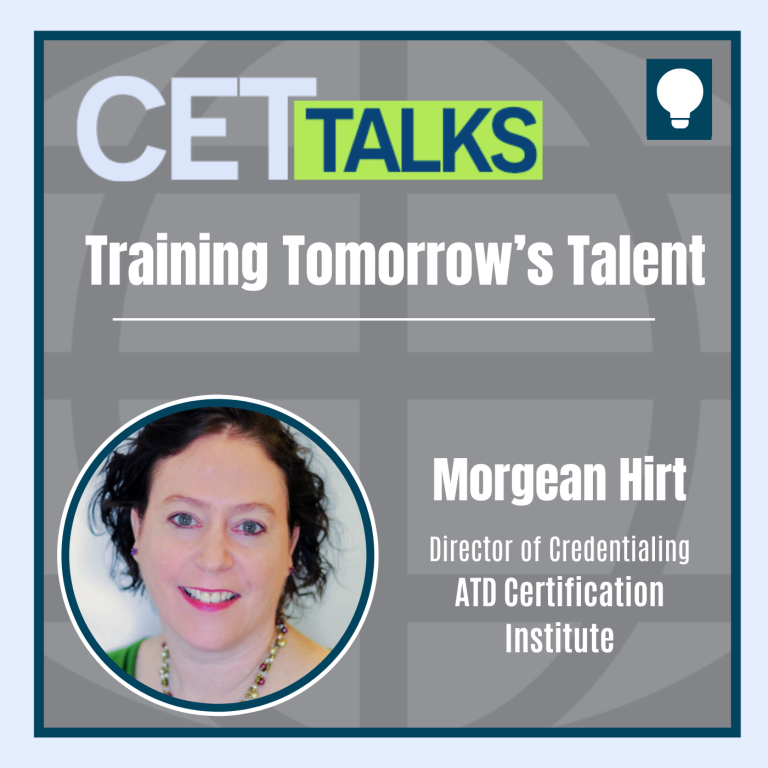
Episode 31: Training Tomorrow’s Talent: Exploring Certification, Standards, and Impact with ATD’s Certification Institute
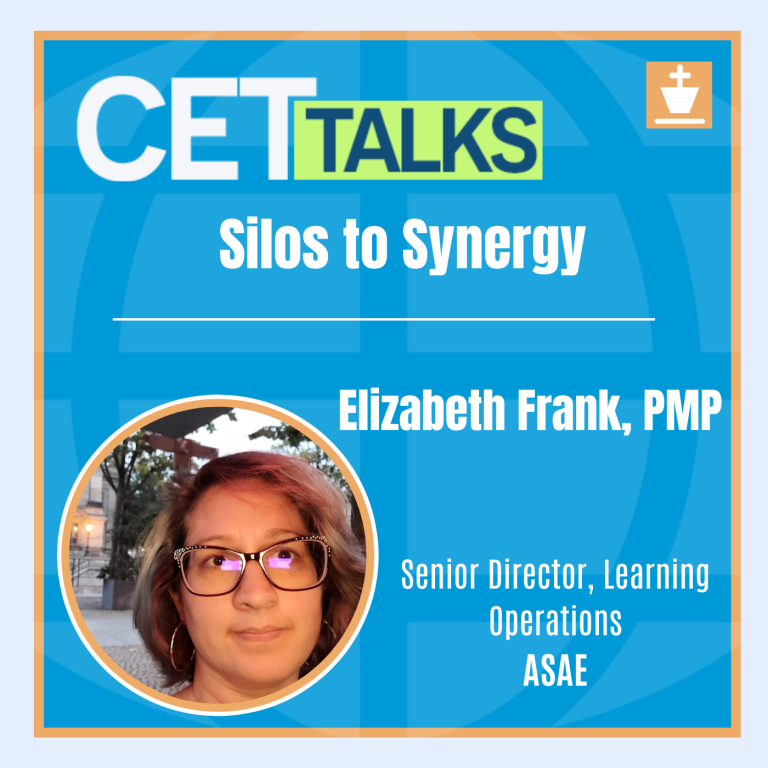
Episode 30: Silos to Synergy: Holistic Approaches to Creating Collaborative Learning

Episode 29: Credentials in Crisis: Challenges and Opportunities in Modern Education Recognition
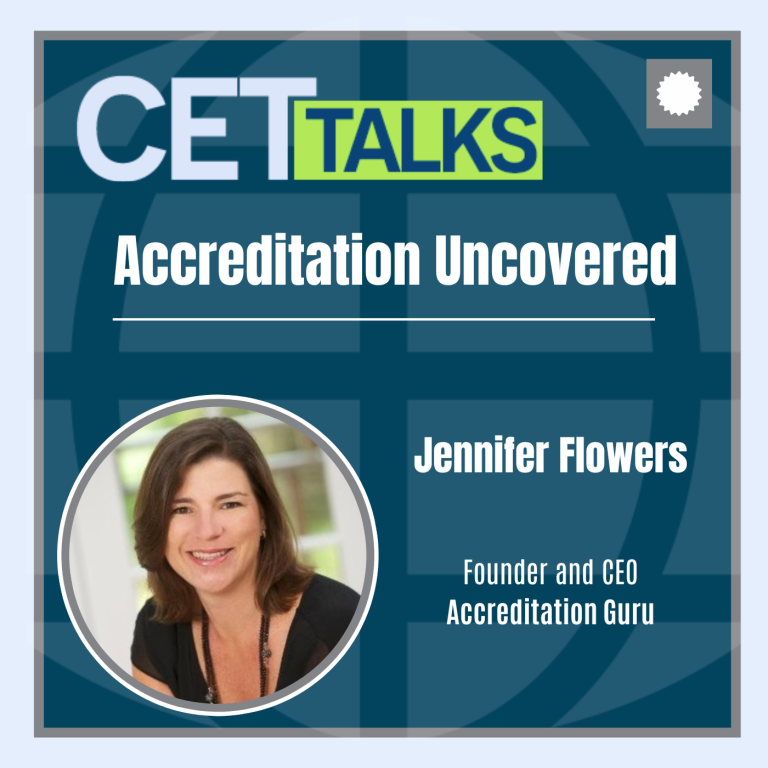
Episode 28: Accreditation Uncovered: Essential Insights from an Industry Leader

Episode 27: Two Truths with a Lie: Managing the Myths of Modern-Day Learning
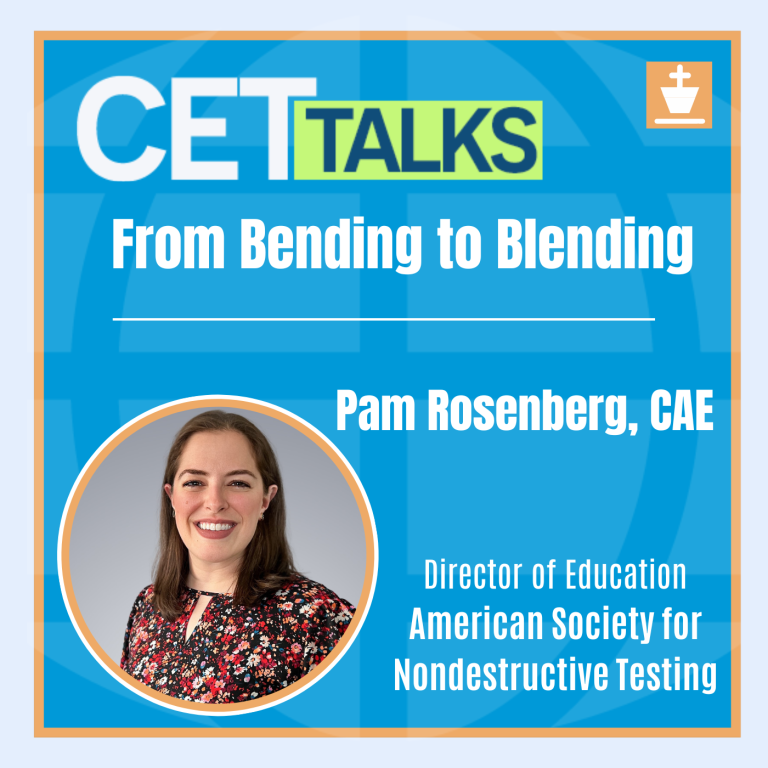
Episode 26: From Bending to Blending: Best Practices in Integrating Externally-Created Content
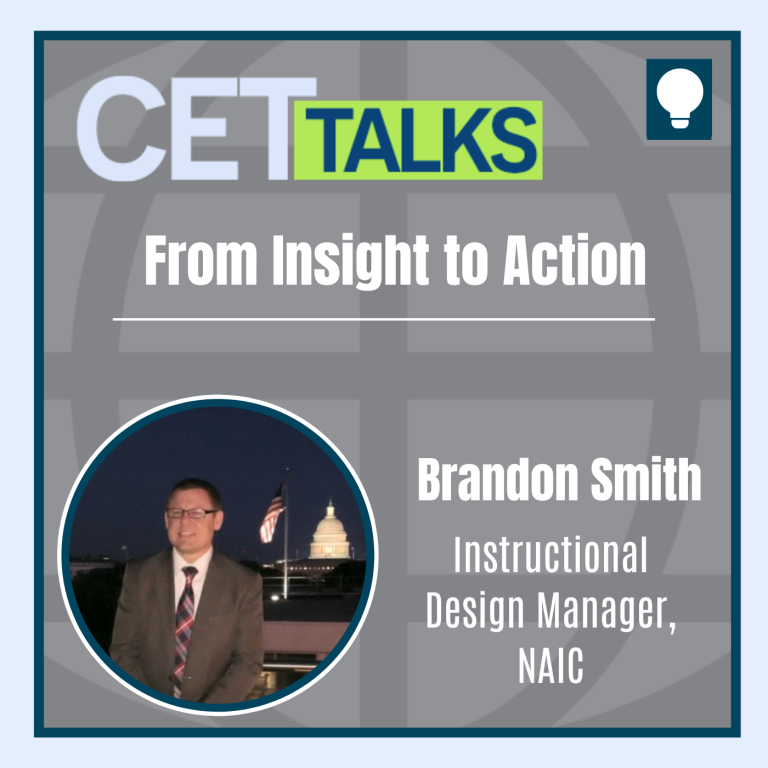
Episode 25: From Insight to Action: Charting the Career Path of a SME-turned-ISD
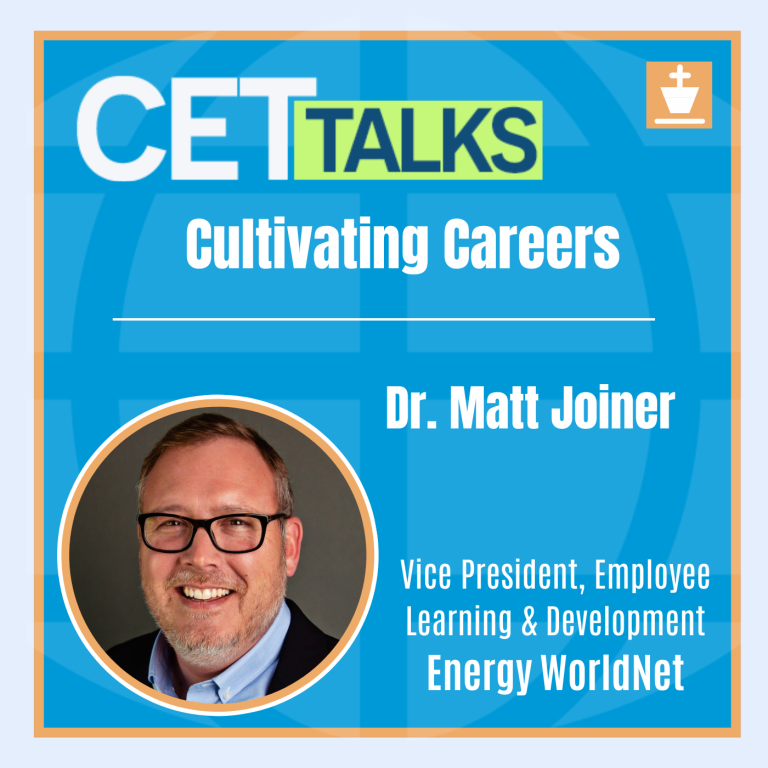
Episode 24: Cultivating Careers: The Power of Employee Engagement for Organizational Success

Episode 23: Igniting Imagination: Crafting Creativity in Training Environments
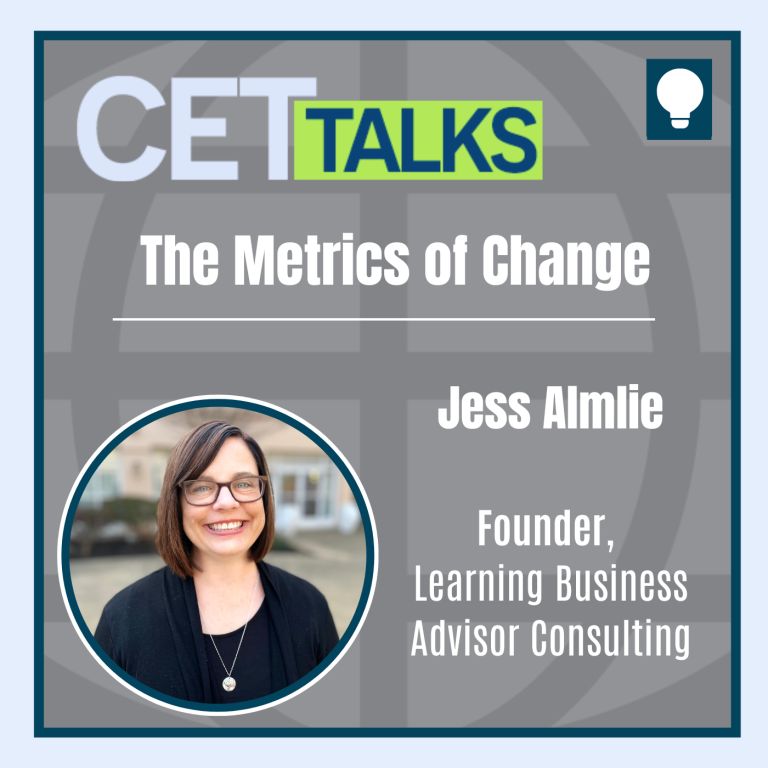
Episode 22: The Metrics of Change: Navigating Purposeful Measurement in L&D
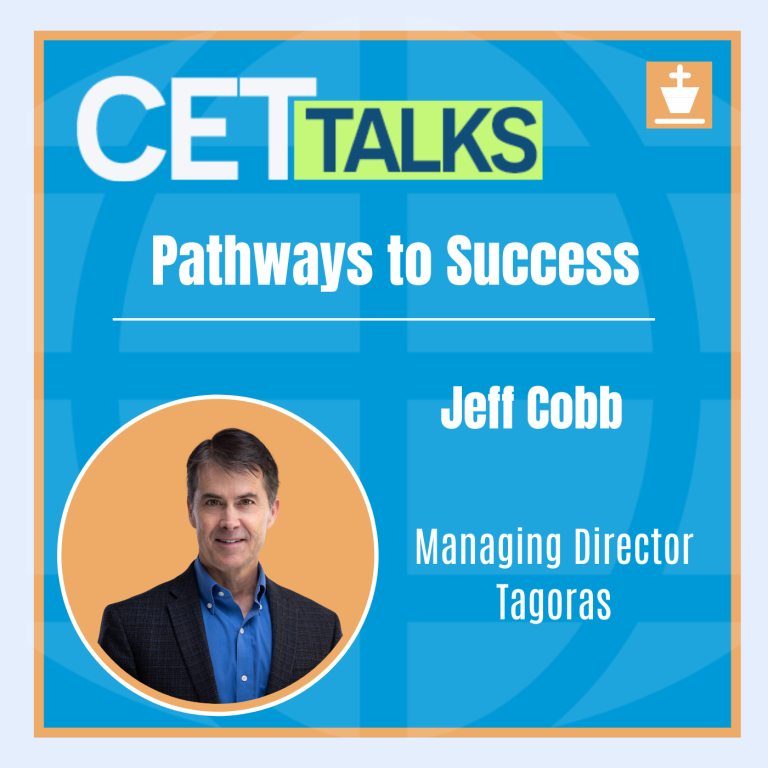
Episode 21: Pathways to Success: The Value of Lifelong Learning through Digital Credentials
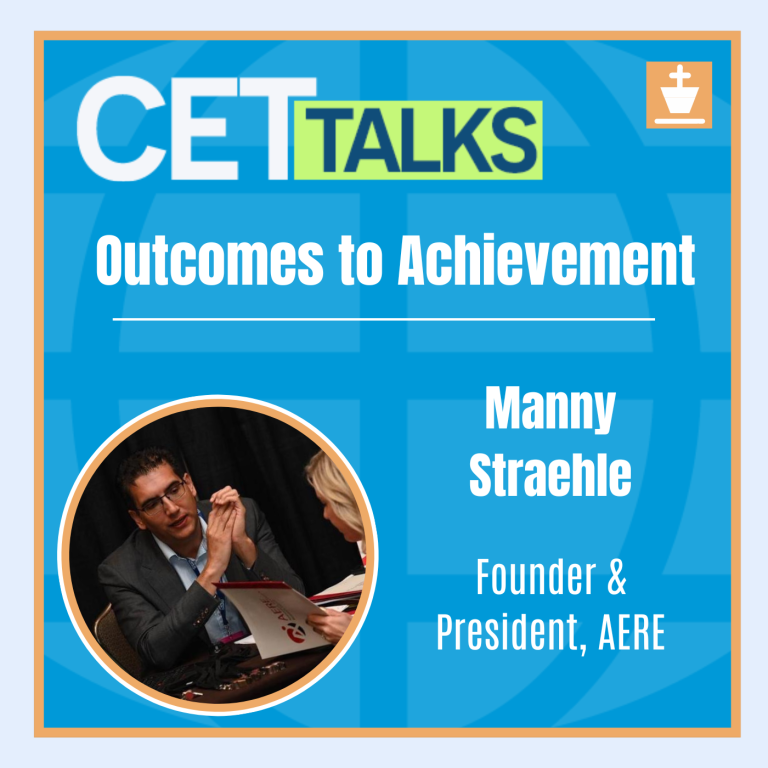
Episode 20: Outcomes to Achievement: Crafting Tomorrow’s Workforce Through Competency Models

Episode 19: Chatting with the Future: Enhancing AI Output Through Prompt Engineering

Episode 18: On the Inclusive Frontier: Harnessing Neurodivergence in Modern Training

Episode 17: Designing with Purpose: Strategies for Accessible e-Learning Development
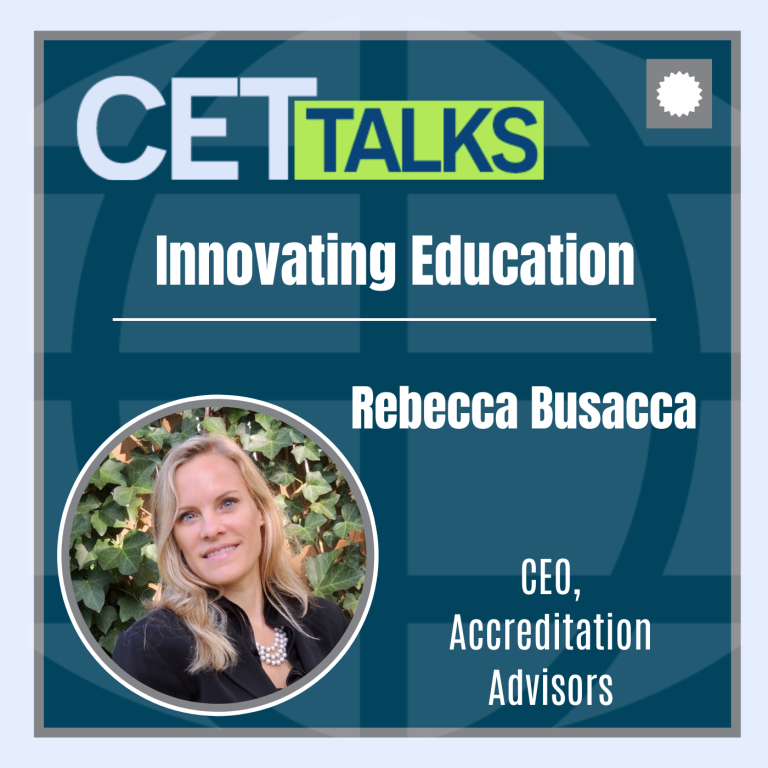
Episode 16: Innovating Education: Navigating Accreditation for Short-Term Training
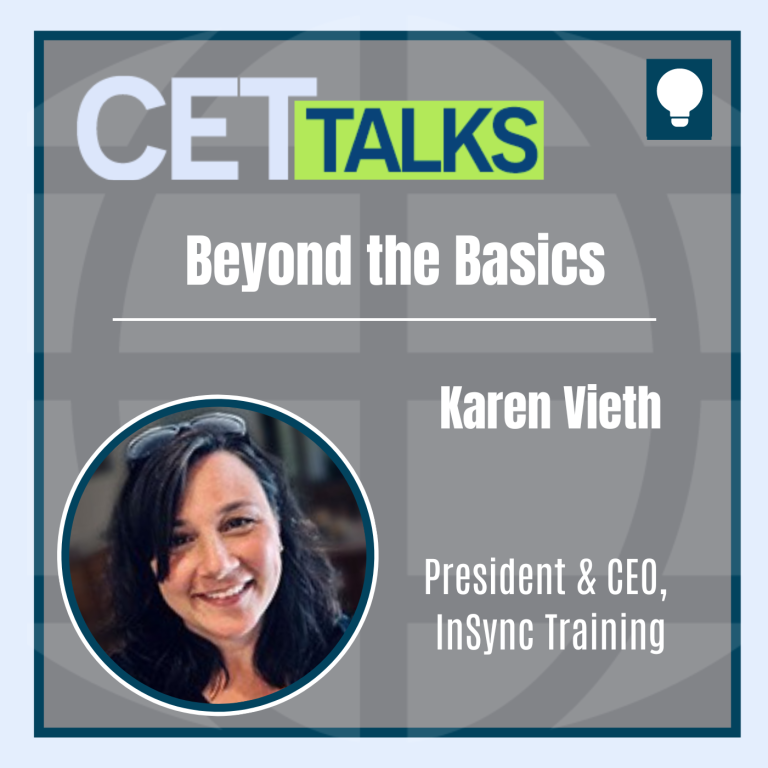
Episode 15: Beyond the Basics: Elevating Virtual Training through Expert Facilitation
